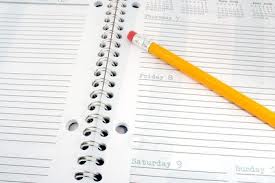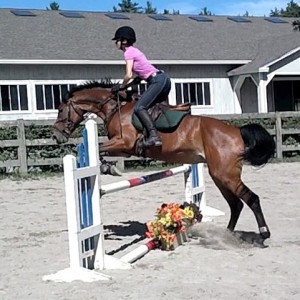As I work toward my goals and continue improving my riding, I find it sometimes helps to seriously focus on what I learned during my lessons. Taking the time to write down the important concepts helps even more! Here are a few notes from my lessons this past week.

I find it important to write down notes from my lessons as well as my daily, monthly and yearly goals.
hope others can learn something too (or remember to focus on something you tend to overlook). If someone out there has some additional pointers or notes please comment!
Cadence
Allow the horse transition time, so in going from canter to trot think – one, two, three – trot (or three beats) same for trot to walk, etc.
Transitions should look and feel very smooth, never abrupt. Count out loud the cadence when trotting, walking or cantering to help focus and relax me and my horse. So that would be a cadence of one beat at the walk, two at the trot and three at canter.
Practice cantering ten strides, then transition to trot for six beats then canter again for ten strides, and so on all in a smooth and effortless manner. Be ever so light on the rein and leg with your requests. Think finely tuned movements, no jarring of the horse, just a whisper.
Leg Yields
Leg yields to the wall. Use your inside leg (heel) and outer rein to bring and keep the horse to and on the outside wall. The horse should move willingly away from your inside leg while the rein helps keep her straight.
Circles
Practice coming into a tight circle, then expanding to a larger one, filling the space, using the heel of your inside leg and outer rein. Practice having the horse turn in on the center line from a large circle, gracefully.
When engaged in circles make sure they are the circle is always the same size (unless you are intentionally bringing them in or out). Keep the same circle shape when changing direction, too. When you ask to move up and the horse doesn’t respond, use two quick movements with both heels to get them to listen and keep doing it until they respond.
The Three Key Elements to Jumping Courses Successfully
The three most important things to consider when jumping a course are track, pace and balance. In order to perfect your track, look at your fence early. Most riders wait until it’s too late. Trying to overcome the wrong track is difficult at best, you can correct for pace and balance pretty fast, but fixing your track quickly is challenging and without the right track the horse will be off balance and not able to perform optimally going over the fence.
You should have an even pace going to a fence and in between fences. Make sure that your stride distance is equal in between the fences, too. So if you want to achieve four strides between the fences, they should be four equal strides.
Figure it Out
If you get your distance wrong twice in a row (or more) then figure out what the problem is and fix it. Same with uneven strides between fences, fix it by going in with the right pace from the start or correct it immediately after the first fence. Do not wait to adjust it at the last fence. You want the horse concentrating on the jump at that point, don’t distract her.
In trying to figure out the problem, ask yourself, did I have the right pace, track, point of take off, equal stride distances, etc.? Where was I off? You should know. Then fix it.
Worth reiterating, correct where you are off early, not at the jump. You need to let the horse “be” at this point. Your conversation with the horse must be a whisper when approaching the fence. If she is on the wrong lead then so be it, leave it and let her jump the fence as is. Horses are fine jumping on the wrong lead or in cross canter. More important is fixing the problem immediately after the fence, especially before the next turn. Just focus on the jump and getting her to land on the correct lead over the fence.
Hands “On” at All Times
Keep your hands in constant contact with the bit until you are through riding. They should not be too tight but taunt enough to feel tension. Keep the contact elastic especially through the elbows. Only when you are done should you relax your reins. When in forward motion give up the rein (towards the horses head) about four to six inches at each stride whether walking, trotting or cantering.
After the Jump
When moving towards a jump (and after a jump) your pace should be smooth and consistent. Don’t go into half seat as it can cause the horse to increase speed. You want to keep them in a relaxed, collected, frame with their pole up. Causing them to speed up can lead them to pull their head down and forward. This is not optimal for balance for the rider.
Keep the pace smooth and stay in your seat in a relaxed manner. If you land hard over the fence when sitting back in your seat it can accomplish the same thing as going into half seat, i.e. it will cause the horse to move faster. With some horses landing hard after a fence tenses the horse to the point where she’s harder to control, i.e. slow down.
Homework
Practice figure eights over a pole and look soon when switching leads back towards the pole. Practice circle work.







